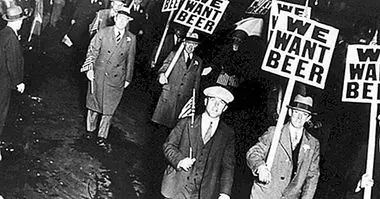Types of feminism and their different currents of thought
Feminism is a set of very varied social and political movements . Partly because of its long historical trajectory and partly because of the diversity of ideological traditions that exist in it, there are many types of feminism, some of which not only propose different strategies to pursue their goals, but also have different objectives.
Next we will see the different main currents of feminism.
Main types of feminism
This classification of currents of feminism should be understood as a simplification, since there are many types of feminism and here only the main branches appear .
1. First wave of feminism
The first wave of feminism, which appeared between the late nineteenth and early twentieth centuries, focused on the search for formal equality between men and women . In other words, they fought for the right to vote for women, the non-discrimination of women in the laws and the possibility that they too could have access to property instead of being simple administrators of the domestic economy.
The type of feminism of this era is fundamentally liberal, and was based on the principles of the Enlightenment. It was a movement that started from the idea that there was no valid reason to break the principle of equality defended by the intellectuals of the Enlightenment and to discriminate against women.
Thus, the perspective of analyzing the reality of the first wave of feminism was based on individualism: women's problems were not seen as social, but as attacks on their individuality and their capacity to accumulate private property.

2. Second wave of feminism
From the second wave of feminism, which occurred between the 60s and the 90s, the number of types of feminism is further diversified by adopting influences from postmodern philosophy and for moving away from the individualism of liberal feminism.
In this new feminism, it is considered that the basic problem of which one wants to finish at the root (hence the "radical" denomination) is a social and historical phenomenon, that is, something that must be attacked from a collectivist perspective. That makes the dialectic inherited from Marxism join the influence of postmodern ideas.
In this generation of feminism appear two main branches: the feminism of difference and that of equality. Both, however, are grouped into a category known as radical feminism, from which it is interpreted that the nature of discrimination against women does not depend on specific legal forms but rather on the basis of a historical system of economic, political and social oppression. cultural called patriarchy.

2.1. Feminism of equality
From the feminism of equality The objective is that women can reach the same status that only men occupy , among other things. In addition, it is understood that gender is a social construct that historically has served to convey oppression towards women through gender roles assigned artificially at birth.
Therefore, equality feminism emphasizes the idea that men and women are essentially human beings, beyond the genders imposed. However, that does not mean that in practice the immediate goal of feminism of equality is equality in itself; As it is understood that part of an imbalance between the sexes, it is possible to defend positive discrimination in some areas, for example, as a temporary measure. For example, a minimum of female representation in parliaments may be required.
Historically, the feminism of equality has been very influenced by Marxism , since unlike feminism of difference focuses on material aspects of the most basic human needs while part of an analysis focused on social phenomena.
2.2. Feminism of difference
From the feminism of difference the objective of ending oppression towards women is set without reference to male status . From this type of feminism defends the idea of vindicating the feminine values (revised so that they are not dictated from a masculine perspective) and its difference with the masculine ones.
Thus, distances are drawn with respect to the idea of feminism understood as a movement that leads to equality, since it is assumed that the feminine needs to have its own space to develop and to endure. This has made both from within feminisms and from outside of them harsh criticism of feminism of difference for being essentialist and defend fundamentally concepts and not people.
3. Third wave of feminism
The third wave of feminism started in the 90s and continues until today.If in the first wave of feminism an identity and interpretative nuance had already been introduced in feminism, here this emphasis placed on subjectivities extends much more, giving place to identities that r , Muslim feminism and many other variants. The idea is to question the perspective of Western and heterosexual white women as a pillar of feminism.
In this generation there is a type of feminism that stands out for its difference from the previous ones: transfeminism.

3.1. Transfeminism
It is one of the types of feminism that drinks more than one of the most radical criticisms of gender binarism : the queer theory According to this, both gender and what is considered to be the biological sex of people are social constructs.
Therefore, people with physical characteristics associated with the feminine cease to be the main subject that must be emancipated through feminism, but empowerment must be achieved by all types of minorities, including people who experience their gender differently from the traditional and that is why they are discriminated against: transsexuals with and without gender dysphoria, genderfluid, etc.
In this way, the feminism that is present in transfeminism no longer has the biological sex of people as a criterion that defines who is oppressed and who is not, and also incorporates identity matrices that have nothing to do with gender, like race and religion.
- Maybe you're interested: "The top 10 types of sexual orientation"
Bibliographic references:
- Bocchetti, Alessandra (1996). What a woman wants. Madrid: Cátedra Editions.
- Molina Petit, C. (1994). Feminist Dialectics of the Enlightenment. Barcelona: Anthropos.
- Varela, N. (2005). Feminism for beginners. Barcelona: Editions B.



















